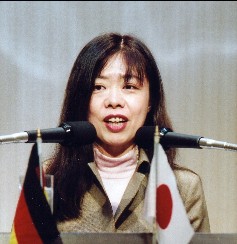Topics behaind ��Rotary-no-tomo"��
April 6th,2005
An editor of the Rotary-no-tomo(a Japanese language Regional Magazine )
Ms. Noriko Futagami
 As the distance between the editor and the readers are much closer than Magazines in general, we are able to hear of their opinions more frequently. With their views in mind, we changed our editing policies from the July, 2002 issue.
As the distance between the editor and the readers are much closer than Magazines in general, we are able to hear of their opinions more frequently. With their views in mind, we changed our editing policies from the July, 2002 issue.
��Rotary International publishes ��The Rotarian��, which is the official organ and there are in the world 31 authorized regional magazines. Although there some rules which we must abide by, we are free to publish magazines which conform to Rotary and culture of the country in which we publish.
��One rule which we must follow are designated articles published in the Rotarian Magazine which we must translate into Japanese for our magazine.
These are called designated articles, and we put a logo mark next to their titles in our magazine.
��Sometimes we find words in English which do not translate well into Japanese.
One was the word ��milestone�� which could not be translated into meaningful Japanese. I have never seen a milestone, but can imagine that it is a stone placed at intervals of a mile for the traveler. Rotary��s intention is clear in that a milestone would be recorded in the centennial year marking our record of service.
��So I used the Japanese term ��fushime�� which means a turning point where we should reflect on our past record and change what must be changed for the future.
��Perhaps this change should not have been done as it changes the meaning somewhat but as cultures differ, I thought that it would be better if the Japanese read it as ��fushime�� so they would be more able to understand the meaning of the message.
��We are running a series of articles commemorating the Centennial on local Rotary projects which can be a milestone, and we have named it ��Centennial Countdown��. This is a designated article to which we have added local news of interest.
��Thus the Rotary-no-tomo has the dual function of being the Japanese edition of The Rotarian and being a bridge for the Japanese members. We hope our Japanese members will be able to appreciate the difference in Rotary in Japan and other parts of the world.
��There is a difference among clubs in Japan too. Your club has a tradition and many members. Furthermore it is a metropolitan club in the city center, on the other hand there are new clubs with barely 20 members. A difference is caused by the cultural traits of the region the club is located, and therefore they perform differently. You will be surprised at some clubs at how different they are. As it is impossible to visit all such clubs, you can understand what they are doing by reading the Rotary-no-tomo��s pages where you can find a report on their activities.
��April being Magazine Month, we have highlighted articles regarding Rotary magazines. A special article is a report on this year��s International Assembly which I was able to attend with our Governor Elects. Every day I sent a report through our Home Page updating the report. This interested our readers and every day during the Assembly, access to our Home Page was double that of usual.
��Our magazine has a 50 year old history. We are trying to maintain our tradition while introducing modern technology. I hope that we will be able to convey information useful Rotarians through our Rotary-no-tomo magazine and our internet Rotary-no-tomo. As you have met face to face the person behind them, I hope that you will feel closer t o Rotary-no-tomo.